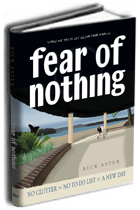In an ideal world, there would never be a post called “Where Do I Start? part 3.” Even “Where Do I Start? part 2” ought to raise a few eyebrows. But “part 3”? “When are you actually going to start?” people might ask.
Clutter, though, is that kind of a problem. It can be hard to address effectively. Clutter is at the root of many other problems in life, so much so that it isn’t reasonable to say that you will put off working on clutter until you are in the right mood or you have enough time, energy, money, strength of purpose, or emotional clarity. Clutter itself may be at the root of all of the problems that serve as excuses. Clutter is the reason you don’t have time. Clutter can sap your energy, confuse your direction in life, and in general keep you from getting things done. You might, then, have to start on clutter before you are really ready.
To make matters worse, a very basic fear, the fear of nothing, may make you hesitate when it comes to clutter. What if you make a mistake and throw away everything that is valuable? This is not a rational fear, but then, the most problematic fears are often the least rational ones. You can overcome the fear of nothing, but to do so, you have to face the fear, and for most people, the easiest way to do that is to face the clutter. Clutter, then, is still the place to start.
So start badly. Start with hesitation if that is what it takes. Make a few mistakes as you go. Start in the completely wrong place. But start somewhere. You will be more ready after you start. So there is no better way to get ready than to get started.
Getting started is the hard part, whether on clutter or any other endeavor that remains a mystery until after you get into it. It is a time to call on whatever mental tricks — or magic tricks — you might have up your sleeve.
The one trick that seems to work for the greatest number of people is visualization. Get out of the clutter zone, which might mean stepping out of the house onto the porch or sidewalk. Once outside, picture yourself doing exactly the work you want to be doing in life, with nothing extra getting in the way. Or take the opposite approach: try to remember all the stuff you have inside the house, perhaps focusing on just one room or area. The latter approach works because clutter is hard to notice and hard to remember. You might remember having too much stuff, but you won’t be able to remember even half of the excess stuff.
After you have that contrasting picture firmly planted in your mind, return to the house and look at what is actually there. It will be a little easier to see that some of the things in the house are, in fact, extra. And that’s the key to the whole process of decluttering. If you can separate the active from the inactive, then you can pull out the clutter — perhaps not all that much of it on the first day, but enough to make the second day a little easier.
Just getting started is so important it doesn’t even matter how long you stay at it on the first day. If you can look around for ten minutes and take out half a grocery bag of junk, that’s a success, and it might even be time to stop for the moment so you can come back the next day and take the next step.
With less clutter, there is more clarity and more room to work. There is more light. Fewer things are hidden or lost. These are just a few of the reasons why it gets easier as you go along. Decluttering is hardest on the first day. The way to make it easier to get through the first day and then through the first layer of clutter. And so, use any trick you know to get yourself started.



No comments:
Post a Comment